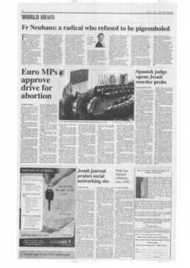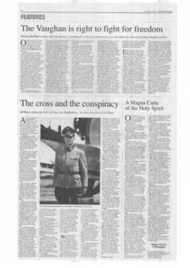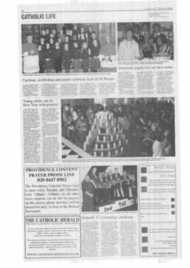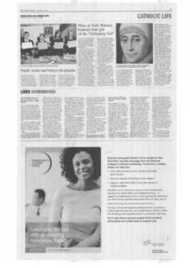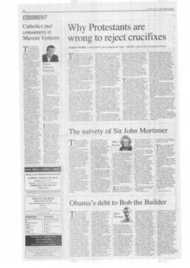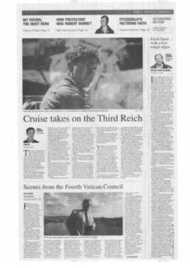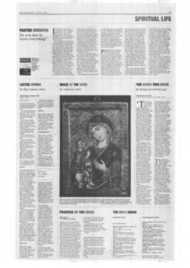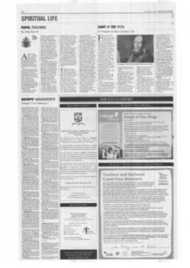Page 15, 23rd January 2009
Page 15

Report an error
Noticed an error on this page?If you've noticed an error in this article please click here to report it.
Tags
Share
Related articles
‘it’s Dangerous To Oversimplify The Council’
The Vatican Chief Who Will Lie For No One
What Vatican Ii Adds Up To
A Change Of Heart
Newman Can Lead Us Out Of Our Post-vatican Ii Turmoil
How Vatican II became the biggest meeting in the history of the world
Anna Arco on two challenging new attempts to make sense of the Council
What Happened at Vatican II?
BY JOHN W O'MALLEY SJ HARVARD UNIVERSITY PRESS £1 6.96
Vatican II
BY MATTHEW LAMB & MATTHEW LEVERING OXFORD UNIVERSITY PRESS £16.99
0 n January 25 1959, Pope John XXIII called the Second Vatican Council. By May preparations for the Council were in full swing and two years later the world's collective eye was drawn to the Vatican, where over 2,400 Council Fathers were gathering.
With them were countless periti (theological advisers), outside observers whose ranks included women, secretaries, support stuff and, of course, journalists. It was, as Fr John W O'Malley Si writes in What Happened at Vatican II, "quite possibly the biggest meeting in the history of the world".
A doctoral student on a fellowship in Rome at the time of the Council, Fr O'Malley was caught up in the excitement of the events, sitting in on some of the meetings and filled with the optimism that carried history forward.
What Happened At Vatican II, which came out late last year, is a narrative history of Vatican 11 as it unfolded from the moment it was called 50 years ago.
Fr O'Malley, a respected Church historian at Georgetown University in Washington DC, explores the Council's lacunae by deconstructing the language of the main documents and the speeches as well as using letters, journals and interviews to build up a well-documented and readable picture of the Council which brought the Church into the 20th century.
In the introduction, Fr O'Malley explains the way that he has interpreted the data, how he has approached the texts and the events. He presents three "issuesunder-issues" which he believes were at the heart of Vatican II.
The first is "development of doctrine" or the problem of change "in an institution that draws its lifeblood from a belief in the transcendent validity of the message it received from the past, which it is duty-bound to proclaim unadulterated". Fr O'Malley identifies the second "issue-under-issues" as "the relationship of centre to the rest of the Church" or whether it had "sidelined the authority of the bishops and become too centralised for its own good".
The third issue is a shift in authority and the way it is exercised, namely a linguistic shill towards a softer-style approach in which words like "charisma", "cooperation", "dialogue" indicate "a new style of thinking, speaking and behaving, a change from a more authoritarian and unidirectional style to a more reciprocal and responsive model".
Vatican II, he argues, marks a
radical shift from the judicial and legislative models of authority used historically in previous Councils because it is "based on persuasion and invitation". It is so obvious, he says, that no one has really paid attention to this third "issue-under-issues". He believes "that this is the issue captured by the expression 'the spirit of the Council', that is, an orientation that goes beyond specific enactments".
He writes: "These three issuesunder-issues, moreover, provide lenses for interpreting the Council. They are a first step toward a hermeneutic that transcends an often myopic, sometimes almost proof-texting approach to the Council that focuses on the wording of the documents without regard for the contexts, without regard for before and after, without regard for vocabulary and literary form. The result is often a minimal interpretation that fails to see the Council as the new moment it wanted to be in the history of the Catholic Church."
As the book unfolds we learn more about the central characters of Vatican II and are given a sense of the excitement that was in the air.
We learn that the period after Vatican I in the 19th century was a difficult one in terms of hierarchy and scholarship, that papal authority was exercised in order to quash academic discourse and coerce the people of God, and that Vatican II marked a dramatic departure from this.
For Fr O'Malley, the three most groundbreaking documents are Gaudium et Spes, the Constitution on the Church in the Modern World, the document on religious freedom and Lumen Gentium (the dogmatic constitution on the Church).
Unfortunately, despite the high level of scholarship and an elegant turn of phrase. What Happened at Vatican 11 never quite manages to go beyond the popular interpretation of the Council as a battle between the conservative dinosaurs in the Curia and the progressive beacons from abroad and the view that it was a distinctive break from the past.
The villains of Fr O'Malley's version of events are the conservative Council Fathers who stood against the heroic progressives who ultimately won the day. Reading the Council as a divide between conservative forces and progressive ones, as well as a distinct break from the Church's tradition, is common to both people who wish that Vatican II had never happened as to those who are most enthusiastic about it. What Happened at Vatican II falls slightly between the cracks as a useful tool for understanding the Second Vatican Councillt presupposes too much prior knowledge of the Council and the documents that it produced to be easily read by an interested lay person but seems like it might not be academic enough an analysis for someone already familiar with the documents and the different interpretations of the Vatican H that already exist.
It feels sometimes as though Fr O'Malley spends so much time looking at what wasn't said that he ignores what was said.
Much more helpful is a hook of essays published by the Oxford University Press which is edited by Matthew L Lamb and Matthew Levering. Vatican II; Renewal within Tradition
explains in the introduction Pope Benedict's notion of a "hermeneutic of continuity", where the renewal and reform of the Council reflect and come out of the tradition of the Church and don't break with the past but grow from it.
Divided up into main chapters for each of the constitutions of Vatican II, the book includes essays by writers like the late Cardinal Avery Dulles SJ, who writes about the Lumen Gentium, and Fr Romanus Cessario OP, who discusses the sacraments.
There are also essays on the decrees and other documents propagated by the Council.
It is almost better, if the reader is keen, to read a couple of the essays, with the Council docu, merits, before reading Fr O'Malley's What Happened at
Vatican II.
blog comments powered by Disqus







